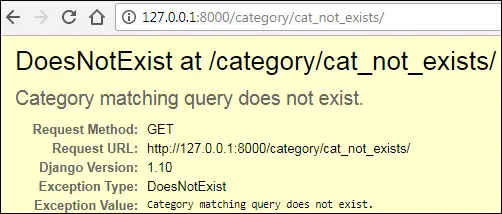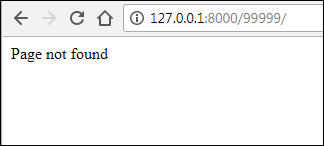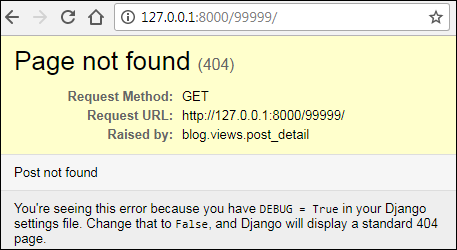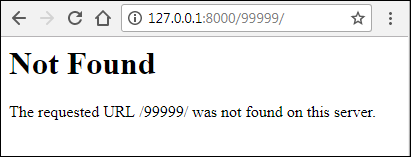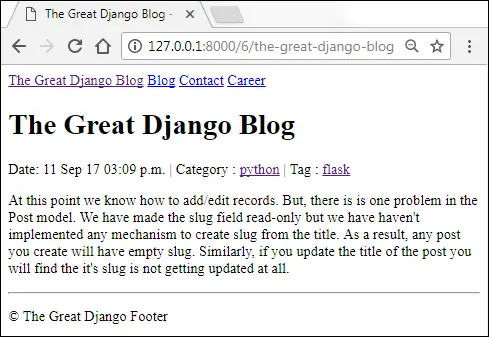Writing views¶
A view function, or view for short, is a Python function that takes a
web request and returns a web response. This response can be the HTML contents
of a web page, or a redirect, or a 404 error, or an XML document, or an image .
. . or anything, really. The view itself contains whatever arbitrary logic is
necessary to return that response. This code can live anywhere you want, as long
as it’s on your Python path. There’s no other requirement–no “magic,” so to
speak. For the sake of putting the code somewhere, the convention is to
put views in a file called views.py, placed in your project or
application directory.
A simple view¶
Here’s a view that returns the current date and time, as an HTML document:
from django.http import HttpResponse import datetime def current_datetime(request): now = datetime.datetime.now() html = "<html><body>It is now %s.</body></html>" % now return HttpResponse(html)
Let’s step through this code one line at a time:
-
First, we import the class
HttpResponsefrom the
django.httpmodule, along with Python’sdatetimelibrary. -
Next, we define a function called
current_datetime. This is the view
function. Each view function takes anHttpRequest
object as its first parameter, which is typically namedrequest.Note that the name of the view function doesn’t matter; it doesn’t have to
be named in a certain way in order for Django to recognize it. We’re
calling itcurrent_datetimehere, because that name clearly indicates
what it does. -
The view returns an
HttpResponseobject that
contains the generated response. Each view function is responsible for
returning anHttpResponseobject. (There are
exceptions, but we’ll get to those later.)
Django’s Time Zone
Django includes a TIME_ZONE setting that defaults to
America/Chicago. This probably isn’t where you live, so you might want
to change it in your settings file.
Mapping URLs to views¶
So, to recap, this view function returns an HTML page that includes the current
date and time. To display this view at a particular URL, you’ll need to create a
URLconf; see URL dispatcher for instructions.
Returning errors¶
Django provides help for returning HTTP error codes. There are subclasses of
HttpResponse for a number of common HTTP status codes
other than 200 (which means “OK”). You can find the full list of available
subclasses in the request/response
documentation. Return an instance of one of those subclasses instead of a
normal HttpResponse in order to signify an error. For
example:
from django.http import HttpResponse, HttpResponseNotFound def my_view(request): # ... if foo: return HttpResponseNotFound("<h1>Page not found</h1>") else: return HttpResponse("<h1>Page was found</h1>")
There isn’t a specialized subclass for every possible HTTP response code,
since many of them aren’t going to be that common. However, as documented in
the HttpResponse documentation, you can also pass the
HTTP status code into the constructor for HttpResponse
to create a return class for any status code you like. For example:
from django.http import HttpResponse def my_view(request): # ... # Return a "created" (201) response code. return HttpResponse(status=201)
Because 404 errors are by far the most common HTTP error, there’s an easier way
to handle those errors.
The Http404 exception¶
-
class
django.http.Http404¶
When you return an error such as HttpResponseNotFound,
you’re responsible for defining the HTML of the resulting error page:
return HttpResponseNotFound("<h1>Page not found</h1>")
For convenience, and because it’s a good idea to have a consistent 404 error page
across your site, Django provides an Http404 exception. If you raise
Http404 at any point in a view function, Django will catch it and return the
standard error page for your application, along with an HTTP error code 404.
Example usage:
from django.http import Http404 from django.shortcuts import render from polls.models import Poll def detail(request, poll_id): try: p = Poll.objects.get(pk=poll_id) except Poll.DoesNotExist: raise Http404("Poll does not exist") return render(request, "polls/detail.html", {"poll": p})
In order to show customized HTML when Django returns a 404, you can create an
HTML template named 404.html and place it in the top level of your
template tree. This template will then be served when DEBUG is set
to False.
When DEBUG is True, you can provide a message to Http404 and
it will appear in the standard 404 debug template. Use these messages for
debugging purposes; they generally aren’t suitable for use in a production 404
template.
Customizing error views¶
The default error views in Django should suffice for most web applications,
but can easily be overridden if you need any custom behavior. Specify the
handlers as seen below in your URLconf (setting them anywhere else will have no
effect).
The page_not_found() view is overridden by
handler404:
handler404 = "mysite.views.my_custom_page_not_found_view"
The server_error() view is overridden by
handler500:
handler500 = "mysite.views.my_custom_error_view"
The permission_denied() view is overridden by
handler403:
handler403 = "mysite.views.my_custom_permission_denied_view"
The bad_request() view is overridden by
handler400:
handler400 = "mysite.views.my_custom_bad_request_view"
Testing custom error views¶
To test the response of a custom error handler, raise the appropriate exception
in a test view. For example:
from django.core.exceptions import PermissionDenied from django.http import HttpResponse from django.test import SimpleTestCase, override_settings from django.urls import path def response_error_handler(request, exception=None): return HttpResponse("Error handler content", status=403) def permission_denied_view(request): raise PermissionDenied urlpatterns = [ path("403/", permission_denied_view), ] handler403 = response_error_handler # ROOT_URLCONF must specify the module that contains handler403 = ... @override_settings(ROOT_URLCONF=__name__) class CustomErrorHandlerTests(SimpleTestCase): def test_handler_renders_template_response(self): response = self.client.get("/403/") # Make assertions on the response here. For example: self.assertContains(response, "Error handler content", status_code=403)
Async views¶
As well as being synchronous functions, views can also be asynchronous
(“async”) functions, normally defined using Python’s async def syntax.
Django will automatically detect these and run them in an async context.
However, you will need to use an async server based on ASGI to get their
performance benefits.
Here’s an example of an async view:
import datetime from django.http import HttpResponse async def current_datetime(request): now = datetime.datetime.now() html = "<html><body>It is now %s.</body></html>" % now return HttpResponse(html)
You can read more about Django’s async support, and how to best use async
views, in Asynchronous support.
When you set debug to False, you don’t have a custom handler, and the status code of the response is 404, the 404.html (if present) in your base template directory is used. To return a response with a 404 status, you can simply return an instance of django.http.HttpResponseNotFound. The reason you got a 500 is because you raised an error instead of returning a response. So, your test function can be simply modified to this
from django.http import HttpResponseNotFound
def test(request):
return HttpResponseNotFound("hello")
Update:
So it turned out that the reason you are getting a 500 error was not that you raised an exception, but having incorrect function signatures. When I answered this question more than half a year ago I forgot that django catches HTTP404 exception for you. However, the handler view has different signatures than the normal views. The default handler for 404 is defaults.page_not_found(request, exception, template_name='404.html'), which takes 3 arguments. So your custom handler should actually be
def customhandler404(request, exception, template_name='404.html'):
response = render(request, template_name)
response.status_code = 404
return response
Although, in this case, you may as well just use the default handler.
- Home
- Django 1.10 Tutorial
- Showing 404 errors In Django
Last updated on July 27, 2020
Visit a category page which doesn’t exist for example, http://127.0.0.1:8000/category/cat_not_exists/. You should see DoesNotExist exception like this:
As there is no such category in the database the URL http://127.0.0.1:8000/blog/category/cat_not_exists/ is completely invalid. In production (i.e when DEBUG=True), instead of throwing a DoesNotExist exception Django will show 500 Internal Server Error.
From the point of view of Search Engine Optimization (SEO), it would be much better to show an HTTP 404 error for the non-existent page instead of showing Internal Server Error or DoesNotExist exception.
The same problem exists in the tag page and the post detail page. Visit any tag or post detail page which doesn’t exist like http://127.0.0.1:8000/tag/tag_not_exists/ or http://127.0.0.1:8000/97712/ and see it yourself.
Showing an HTTP 404 page #
Django provides two ways to show 404 error.
HttpResponseNotFoundclassHttp404exception
Let’s start with HttpResponseNotFound class.
HttpResponseNotFound class #
The HttpResponseNotFound class is an extension of HttpResponse class. It works just like HttpResponse but instead of returning a 200 status code , it returns 404 (which means page not found). To see how it works, open views.py and modify the post_detail() view as follows:
TGDB/django_project/blog/views.py
1 2 3 4 5 6 7 8 9 10 11 12 13 |
from django.http import HttpResponse, HttpResponseNotFound #... # view function to display a single post def post_detail(request, pk): try: post = Post.objects.get(pk=pk) except Post.DoesNotExist: return HttpResponseNotFound("Page not found") return render(request, 'blog/post_detail.html', {'post': post}) #... |
Here we are wrapping the code which might throw an exception in the try and except block. Now, If get() method throws a DoesNotExist exception then instead of displaying an error page, Django will show a 404 error page with "Page not found" response. Save the changes and visit http://127.0.0.1:8000/99999/, you should get a response like this:
Http404 exception #
Another way to show a 404 error page is to raise Http404 exception. Notice that unlike HttpResponseNotFound class, Http404 is an exception. Http404 uses a default 404 page which Django provides. To use it just raise Http404 exception in your code like this:
You can also provide an error message while raising Http404 exception.
raise Http404("Some error message")
Open views.py file and amend post_detail() view as follows:
TGDB/django_project/blog/views.py
1 2 3 4 5 6 7 8 9 10 11 12 13 |
from django.http import HttpResponse, HttpResponseNotFound, Http404 #... # view function to display a single post def post_detail(request, pk): try: post = Post.objects.get(pk=pk) except Post.DoesNotExist: raise Http404("Post not found") return render(request, 'blog/post_detail.html', {'post': post}) #... |
Save the file and visit http://127.0.0.1:8000/blog/99999/, you will see the following 404 error page.
We are currently in development mode. In production (i.e when DEBUG=False) Django will show 404 page which looks like this:
The get_object_or_404() method #
Most of the time our views function goes like this:
- Code try and except block.
- Query the database in the try block.
- If an exception is thrown, catch the exception in the except block and show a 404 page.
This pattern is so common that Django a provides a shortcurt method called get_object_or_404(). Here is the syntax of get_object_or_404().
Syntax: get_object_or_404(klass, **kwargs)
The klass can be a model, a manager or a Queryset object.
The **kwargs represents all keyword arguments as well as lookup parameters that we have been using with the get() and filter() method.
On success, it returns a single object of the given model, if it can’t find any records then it raises a Http404 exception.
Internally this method calls get() method of objects manager, so you must always use this method to get a single record.
To use get_object_or_404() first import it from django.shortcuts using the following code.
from django.shortcuts import get_object_or_404
The following examples shows how to use get_object_or_404() method with models, queryset and managers. It also shows that when a matching record is not found, get_object_or_404() raises a Http404 exception.
Example 1: where klass is model
1 2 3 4 5 6 7 8 9 10 11 12 13 14 15 |
>>> >>> from django.shortcuts import get_object_or_404 >>> from blog.models import Category, Post, Tag, Author >>> post = get_object_or_404(Post, pk=1) >>> >>> post <Post: Post 1> >>> >>> >>> post = get_object_or_404(Post, pk=990) Traceback (most recent call last): ... django.http.response.Http404: No Post matches the given query. >>> >>> |
The above code is equivalent to:
>>> >>> try: ... post = Post.objects.get(pk=1) ... except Post.DoesNotExist: ... raise Http404("Post not found") ... >>> |
Example 2: where klass is queryset
>>> >>> queryset = Post.objects.filter(title__contains="Post 1") >>> queryset <QuerySet [<Post: Post 1>]> >>> >>> post = get_object_or_404(queryset, pk=1) >>> >>> post <Post: Post 1> |
>>> >>> >>> post = get_object_or_404(queryset, pk=10) # get_object_or_404() will now raise an exception Traceback (most recent call last): ... raise Http404('No %s matches the given query.' % queryset.model._meta.object _name) django.http.response.Http404: No Post matches the given query. >>> >>> |
Example 3: where klass is manager
>>> >>> c = Category.objects.get(name='java') >>> c <Category: java> |
1 2 3 4 5 6 7 8 9 10 11 12 13 14 |
>>> >>> post = get_object_or_404(c.post_set, title__contains="Post 2") >>> >>> post <Post: Post 2> >>> >>> >>> post = get_object_or_404(c.post_set, title__contains="tagged") Traceback (most recent call last): ... raise Http404('No %s matches the given query.' % queryset.model._meta.object_name) django.http.response.Http404: No Post matches the given query. >>> >>> |
Let’s update our post_detail() view to use get_object_or_404() method.
TGDB/django_project/blog/views.py
#... from django.shortcuts import render, get_object_or_404 #... # view function to display a single post def post_detail(request, pk): post = get_object_or_404(Post, pk=pk) return render(request, 'blog/post_detail.html', {'post': post}) #... |
The get_list_or_404() method #
The get_list_or_404() works just like get_object_or_404() method, but instead of returning a single result, it returns a queryset object. If no matching results found, it raises a Http404 exception.
Open views.py file and update post_by_category() and post_by_tag() view functions to use get_list_or_404() method as follows:
TGDB/django_project/blog/views.py
1 2 3 4 5 6 7 8 9 10 11 12 13 14 15 16 17 18 19 20 21 22 23 24 25 |
#... from django.shortcuts import render, get_object_or_404, get_list_or_404 #... # view function to display post by category def post_by_category(request, category_slug): category = get_object_or_404(Category, slug=category_slug) posts = get_list_or_404(Post, category=category) context = { 'category': category, 'posts': posts } return render(request, 'blog/post_by_category.html', context) # view function to display post by tag def post_by_tag(request, tag_slug): tag = get_object_or_404(Tag, slug=tag_slug) posts = get_list_or_404(Post, tags=tag) context = { 'tag': tag, 'posts': posts, } return render(request, 'blog/post_by_tag.html', context ) |
After updating views, visit any non-existent category page, tag page or post detail page, you should get a proper HTTP 404 error.
Creating SEO friendly URLs #
As the situation stands, our post detail page URLs looks like http://127.0.0.1:8000/6/. Although it is working fine, the problem is that by looking at the URL nobody can tell what the post is about. It would be good to create URLs which describes something about the post.
For our blog, we will create a URL pattern like the following:
http://example.com/post-pk/post-slug
Let’s implement this URL pattern.
Open urls.py in the blog app and amend post_detail URL pattern as follows:
TGDB/django_project/blog/urls.py
#... urlpatterns = [ url(r'^category/(?P<category_slug>[w-]+)/$', views.post_by_category, name='post_by_category'), url(r'^tag/(?P<tag_slug>[w-]+)/$', views.post_by_tag, name='post_by_tag'), url(r'^(?P<pk>d+)/(?P<post_slug>[wd-]+)$', views.post_detail, name='post_detail'), url(r'^$', views.post_list, name='post_list'), ] |
Update post_detail() view function to accept another parameter called post_slug as follows:
TGDB/django_project/blog/views.py
#... # view function to display a single post def post_detail(request, pk, post_slug): post = get_object_or_404(Post, pk=pk) return render(request, 'blog/post_detail.html', {'post': post}) #... |
At last, we need to modify the get_absolute_url() method of the Post model. Open models.py and update get_absolute_url() method of Post model as follows:
TGDB/django_project/blog/models.py
#... class Post(models.Model): #... def get_absolute_url(self): return reverse('post_detail', args=[self.id, self.slug]) #... |
As we are using get_absolute_url() method to generate links to post detail page in our templates, we don’t need to modify anything else. All templates will pick the changes automatically.
To view the updated URL visit http://127.0.0.1:8000/ and click on any post detail page.
Listing posts in reverse chronological order #
Currently, all pages of our site display posts in the order in which they are inserted into the database. For usability purpose, it would be much better to display posts in reverse chronological order i.e latest first, oldest last.
This change would be very simple. Open views.py in the blog app and update post_list(), post_by_category() and post_by_tag() views as follows:
TGDB/django_project/blog/views.py
1 2 3 4 5 6 7 8 9 10 11 12 13 14 15 16 17 18 19 20 21 22 23 24 25 26 27 28 29 30 31 32 33 34 |
#... # view function to display a list of posts def post_list(request): posts = Post.objects.order_by("-id").all() return render(request, 'blog/post_list.html', {'posts': posts}) # view function to display a single post def post_detail(request, pk, post_slug): post = get_object_or_404(Post, pk=pk) return render(request, 'blog/post_detail.html', {'post': post}) # view function to display post by category def post_by_category(request, category): category = get_object_or_404(Category, slug=category_slug) posts = get_list_or_404(Post.objects.order_by("-id"), category=category) context = { 'category': category, 'posts': posts } return render(request, 'blog/post_by_category.html', context) # view function to display post by tag def post_by_tag(request, tag): tag = get_object_or_404(Tag, slug=tag_slug) posts = get_list_or_404(Post.objects.order_by("-id"), tags=tag) context = { 'tag': tag, 'posts': posts } return render(request, 'blog/post_by_tag.html', context ) |
From now on, all the pages of our blog will display posts in reverse chronological order.
Note: To checkout this version of the repository type git checkout 18a.
If you are developing a web application, then most probably you will come across situations where you need to show the 404 (not found) page. We will talk about this in this article.
When you should return 404
It is a good practice to use a 404 page in cases when users are accessing the wrong URLs, for instance, when the link you used to access the page is broken. We will also talk about how to use the right status code for this situation. You should return 404 HTTP error if one of the following is true:
- The page does not exist.
- The requested page was deleted.
- Page not found.
Python Django provides a number of functions to customize the 404 page. Using them you can easily configure your 404 page without having to write a new view function. Let’s have a look at how to return a 404 error in Django.
First, import Http404 from django.http module. Next, raise the Http404 exception within your view. For example, here is views.py file for the view which always returns 404:
from django.http import Http404
def not_found(req):
raise Http404
Remember to route the not_found view. To do it, write the following to urls.py:
from . import views
from django.urls import path
urlpatterns = [
# ...your other routes...
path('nowhere/', views.not_found), # for 404 demo
]
You should not do this in production apps. We do it now just for the sake of demonstration. Now, restart your application. If you go to the routed URL /nowhere/, you will see one of the following:
- If you have
DEBUG=Trueset insettings.pyyou will see Django app traceback. - Otherwise, you will see the 404 error template you specified in
settings.pyortemplates/404.html
Using get_object_or_404 function
Sometimes you need to retrieve a model from a database and return 404 error if the model does not exist. Of course, you can use an if-else statement, but you can use a shortcut, get_object_or_404 function. See the code example below:
from django.shortcuts import get_object_or_404, render
# example model - use models.py to create one
from app.models import Page
def get_page(req, page_id):
page = get_object_or_404(Page, id=page_id)
return render(req, 'app/page.html', { 'text': page.text })
We used an imaginary template ‘app/page.html’, which renders the text variable we passed. If the Page model with id page_id does not exists, Django will return the 404 not found error.
Conclusion
To return 404 in Django Framework, you should include the Http404 exception and raise it within a view function. Also you can use get_object_or_404 function from django.shortcuts if you retrieve a model from a database in your view. You learned how to return 404 error and get it handled correctly.
{% load static %}
<!DOCTYPE html>
<html class="no-js" lang="en">
<head>
<meta charset="utf-8">
<title>Web Developer</title>
<link href="{% static 'img/Demo/favicon.png' %}" rel="shortcut icon"/>
<meta charset="UTF-8" />
<meta http-equiv="X-UA-Compatible" content="IE=edge">
<meta name="description" content="Alphaandroid - Creative Agency of web developers">
<meta name="author" content="Pavan And Romil">
<meta name="keywords" content="Web developer (using coding), Digital Marketing" />
<meta name="viewport" content="width=device-width, initial-scale=1, maximum-scale=1">
<link rel="stylesheet" href="{% static 'css/error404/base.css' %}">
<link rel="stylesheet" href="{% static 'css/error404/main.css' %}">
<link rel="stylesheet" href="{% static 'css/error404/vendor.css' %}">
<script src="{% static 'js/error404/modernizr.js' %}"></script>
<link rel="icon" type="image/png" href="{% static 'favicon.png' %}">
<script>(function(w,d,s,l,i){w[l]=w[l]||[];w[l].push({'gtm.start':
new Date().getTime(),event:'gtm.js'});var f=d.getElementsByTagName(s)[0],
j=d.createElement(s),dl=l!='dataLayer'?'&l='+l:'';j.async=true;j.src=
})(window,document,'script','dataLayer','GTM-MRJ5QRJ');
</script>
</head>
<body>
height="0" width="0" style="display:none;visibility:hidden"></iframe></noscript>
{% comment %}
<header class="main-header">
<div class="row">
<div class="logo">
<a href="index.html">Alpha Android</a>
</div>
</div>
<a class="menu-toggle" href="#"><span>Menu</span></a>
</header>
{% endcomment %}
{% comment %}
<nav id="menu-nav-wrap">
<h5>Site Pages</h5>
<ul class="nav-list">
<li><a href="/" title="">Home</a></li>
<li><a href="#" title="">About</a></li>
<li><a href="#" title="">Contact</a></li>
</ul>
<h5>Some Text</h5>
<p>Lorem ipsum Non non Duis adipisicing pariatur eu enim Ut in aliqua dolor esse sed est in sit exercitation eiusmod aliquip consequat.</p>
</nav>
{% endcomment %}
<main id="main-404-content" class="main-content-particle-js">
<div class="content-wrap">
<div class="shadow-overlay"></div>
<div class="main-content">
<div class="row">
<div class="col-twelve">
<h1 class="kern-this">404 Error.</h1>
<p>
Oooooops! Looks like nothing was found at this location.
Maybe try one of the links below, click on the top menu
or try a search?
</p>
{% comment %}
<div class="search">
<form>
<input type="text" id="s" name="s" class="search-field" placeholder="Type and hit enter …">
</form>
</div>
{% endcomment %}
</div>
</div>
</div>
<footer>
<div class="row">
<div class="col-seven tab-full social-links pull-right">
<ul>
<li><a href="#"><i class="fa fa-facebook"></i></a></li>
<li><a href="#"><i class="fa fa-behance"></i></a></li>
<li><a href="#"><i class="fa fa-twitter"></i></a></li>
<li><a href="#"><i class="fa fa-dribbble"></i></a></li>
<li><a href="#"><i class="fa fa-instagram"></i></a></li>
</ul>
</div>
<div class="col-five tab-full bottom-links">
<ul class="links">
<li><a href="/">Homepage</a></li>
<li><a href="/about-us/">About Us</a></li>
{% comment %}
<li><a href="/contact-us/">Contact Us</a></li>
{% endcomment %}
<li><a href="mailto:Contact@alphaandroid.com">Report Error</a></li>
</ul>
<div class="credits">
</div>
</div>
</div>
</footer>
</div>
</main>
<div id="preloader">
<div id="loader"></div>
</div>
<script src="{% static 'js/error404/jquery-2.1.3.min.js' %}"></script>
<script src="{% static 'js/error404/plugins.js' %}"></script>
<script src="{% static 'js/error404/main.js' %}"></script>
</body>
</html>

